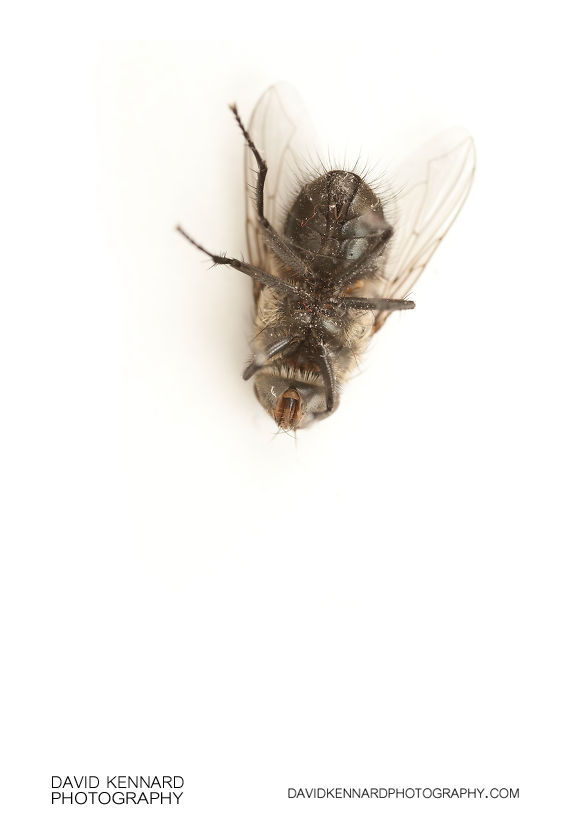Underside of a Cluster fly (Pollenia sp.)

Description
- Title:
- Underside of a Cluster fly (Pollenia sp.)
- Caption / Description:
-
The cluster flies are the genus Pollenia in the blowfly family Calliphoridae. Unlike more familiar blowflies such as the bluebottle genus Phormia, they do not present a health hazard because they do not lay eggs in human food. They are strictly parasitic on earthworms; the females lay their eggs near earthworm burrows, and the larvae then infest the worms.
However, the flies are a nuisance because when the adults emerge in the late summer or autumn they enter houses to hibernate, often in large numbers; they are difficult to eradicate because they favour inaccessible spaces such as roof and wall cavities. They are often seen on windows of little-used rooms. They are also sometimes known as attic flies.
The typical cluster fly Pollenia rudis is about 7 mm long and can be recognised by distinct lines or stripes behind the head, short golden-coloured hairs on the thorax, and irregular light and dark gray areas on the abdomen. Cluster flies are typically slow moving.
Cluster flies have a widespread distribution. Six species are found in Britain and thirty one in Europe. Pollenia species are also and numerous in Australia and New Zealand (over 30 spp); they are a common pest in North America. P. rudis has spread widely in association with humans.
Description taken from Wikipedia: http://en.wikipedia.org/wiki/Pollenia
- Tags / Keywords:
-
- Biota
- Life
- Vitae
- Eukaryota
- Animalia
- Animals
- Arthropoda
- Arthropods
- Insecta
- Insects
- Diptera
- Flies
- Calliphoridae
- Blow flies
- Cluster flies
- Pollenia
Admin
- Date Original Photo Taken:
- Original File Name:
- _MG_4739.psd
- Event:
- Rating:
- Date this image added/last updated on website:
- Original File Dimensions:
- 2848px x 4272px
- File Type:
- JPEG
- Color Mode:
- RGB
- Original Image Color Profile:
- Adobe RGB (1998)
Location
- Location Created:
-
- Sublocation:
- City:
- Market Harborough
- Province/State:
- Leicestershire
- Country:
- United Kingdom
- World Region:
- Europe
- Geo-location:
Rights
- Copyright Status:
- Copyrighted
- Licensing Status:
- Rights Managed
- Available for Editorial Use:
- Yes
- Available for Commercial Use:
- Yes
- Copyright Notice:
- © 2010 Dave Kennard
Camera Data
- Date Digital Resource was created:
- Shutter speed:
- 1⁄200 s
- Aperture:
- f/8
- Camera Model:
- Canon EOS 450D
- ISO:
- 100
- Exposure Compensation:
- 0
- Focal Length:
- 65mm
- Focal Length (35mm equiv.):
- Metering Mode:
- Multi-segment
- Flash:
- On, Fired
- Exposure Mode:
- Manual
- White Balance:
- Manual
- Light Source:
- Exposure Program:
- Manual
Additional shooting metadata
- Lens:
- Canon MP-E 65mm F2.8 1-5x Macro
- Filters used:
- Additional Optics used:
- Setup:
- Handheld
Canon MT-24EX Macro Twin Flash with home-made concave diffusers
Post Processing
- Image Modified:
- Software used:
-
- Adobe Camera RAW
- Adobe Photoshop CS5
- Post Processing:
CR2 converted in ACR
Composition modified in PS CS5
